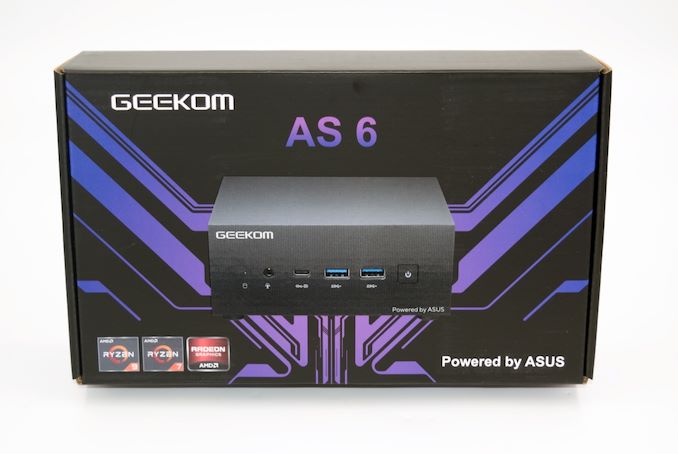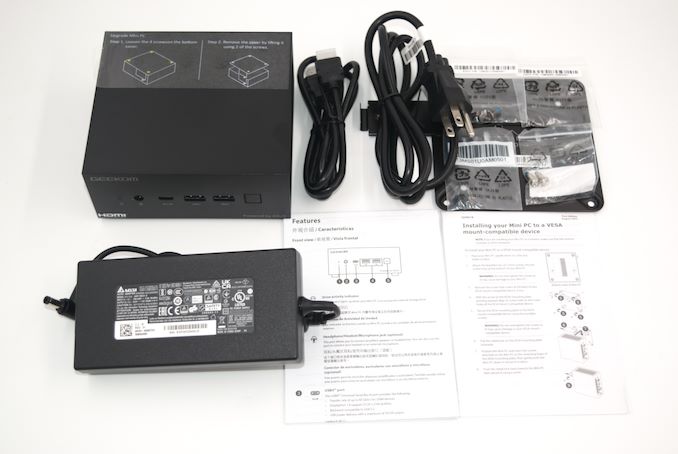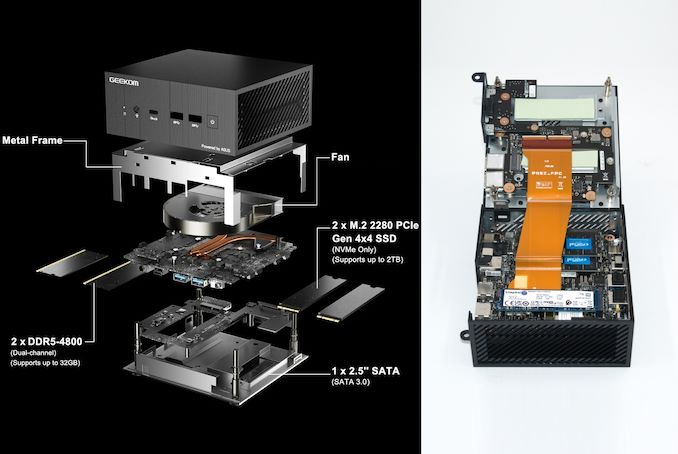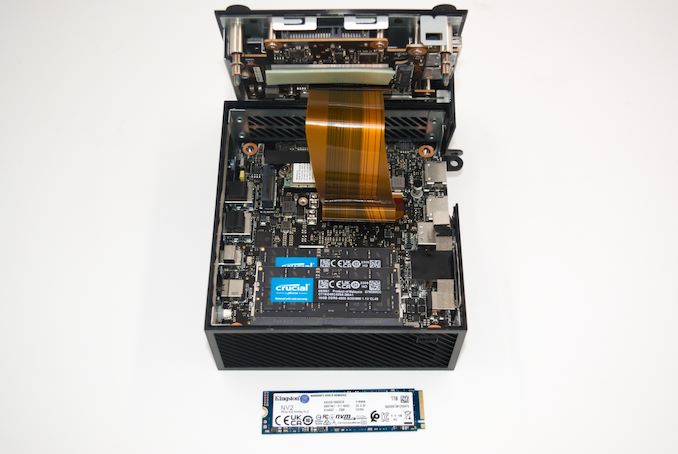GEEKOM AS 6 (ASUS PN53) Review: Ryzen 9 6900HX Packs Punches in a Petite Package
by Ganesh T S on July 31, 2023 8:00 AM EST
The market demand for small form-factor (SFF) PCs was kickstarted by the Intel NUC in the early 2010s. Since then, many vendors have come out with their own take on the Intel NUC using both Intel and AMD processors. In recent years, we have also seen various Asian companies such as Beelink, Chuwi, GEEKOM, GMKtec, MinisForum, etc. emerging with a focus solely on these types of computing systems. We had looked at GEEKOM's Jasper Lake offering - the MiniAir 11 - last year, and came away satisfied with the build quality of the device.
Earlier this year, GEEKOM announced a tie-up with ASUS to market specific configurations of the ASUS ExpertCenter PN53 under their own brand as the GEEKOM AS 6. Based on AMD's Rembrandt line of notebook processors, the GEEKOM AS 6 comes with a choice of the Ryzen 9 6900HX, Ryzen 7 6800H, or the Ryzen 7 7735H.
The CPU choices all belong to the Rembrandt family of SoCs utilizing CPU cores with the Zen 3+ microarchitecture. While the Ryzen 9 6800HX and the Ryzen 7 6800H were released in early 2022, the Ryzen 7 7735H was launched as a China-only SKU earlier this year along with a few other 'Rembrandt Refresh' SoCs. We have already taken a detailed look at the ASRock Industrial 4X4 BOX-7735U based on one such refresh SKU - the Ryzen 7 7735U.
The initial wave of systems based on Rembrandt SoCs impressed with their performance, but the connectivity aspects did not measure up to the possibilities enabled by Thunderbolt in the Intel ecosystem. Over the last few quarters, that has perceptibly changed with the USB4 capabilities of the SoCs (including PCIe tunneling support) getting reflected in the newer set of Rembrandt systems. Most mid-range and high-end systems based on Rembrandt now come with full-featured USB4 ports, and the GEEKOM AS 6 is no exception. The company sent across their flagship configuration - the AS 6 equipped with a Ryzen 9 6900HX, 32GB of DDR5 RAM, and a 1TB Gen4 x4 NVMe SSD - to put through our evaluation routine for small form-factor computing systems. This review explores the performance profile and value proposition of the GEEKOM AS 6.
Introduction and Product Impressions
Small form-factor (SFF) systems have been replacing bulky desktops for many use-cases in recent years. The rapid growth in this segment has created a number of companies (mainly based out of Asia) focusing on these systems. GEEKOM is a private label brand of Shenzhen Jiteng Network Technology Co., Ltd. - an OEM / ODM for small form-factor computing systems. The company manufactures both Intel and AMD-based systems. For the latter, the company has a tie-up with ASUS. The GEEKOM AS 5 (using AMD Cezanne SoCs) introduced last year was a rebranded version of the ASUS ExpertCenter PN52. The GEEKOM AS 6 we are looking at in this review is a rebrand of the ASUS ExpertCenter PN53, and uses high-end Rembrandt SoCs. The Ryzen 9 6900HX processor in the AS 6 review system has a 8C / 16T (Zen 3+) configuration fabricated in TSMC's 6nm process. In addition to the minor improvements in CPU performance over the Zen 3 / Cezanne family, the integrated GPU has also migrated from the Vega-based ones in previous generations to the RDNA2-based Radeon 680M.
GEEKOM's package components for the AS 6 differs from the ASUS PN53's. We have seen in previous ASUS mini-PC reviews that a wired keyboard and mouse are always bundled in the retail kit. GEEKOM opts to keep things simple and compact by shipping the main system, a VESA mount, a few screws for the SATA and M.2 drives, and a 150W power adapter (20V @ 7.5A) along with a quick-start guide.
The company also keeps the ASUS branding in the front panel, and the system supports all of the software value additions available for the ASUS PN53. On the hardware front, the system clocks in at 120mm x 130mm x 58mm (compared to a full-height mainstream NUC at 117mm x 112mm x 54mm). The larger dimensions allow for a wider variety of ports in the system. Unlike the mainstream Intel NUCs that adopt a single PCB layout, the GEEKOM AS 6 adopts a motherboard / daughterboard strategy with a flexible printed circuit (FPC) connector, as shown below.
The daughterboard includes a Gen4 x4 M.2 SSD slot as well as the SATA connector and the non Type-C display outputs. The DDR5 SODIMM slots and one of the Gen4 x4 M.2 SSD slots on the main board are pre-populated in the GEEKOM configurations. The WLAN / BT module is under the primary NVMe SSD slot (similar to the mainstream Intel NUCs). The metal frame, coupled with the thermal pads for both Gen4 M.2 slots point to some thought being put in to keep the SSD temperatures under check. There is also a 2.5" SATA drive slot in the system. However, with no direct active airflow on that side of the board, it may not be ideal to install one in addition to the M.2 SSDs. The external I/O includes five display outputs (including the two USB4 Type-C ports), but only four of them can be active at a time.
The GEEKOM AS 6 review configuration was equipped with 2x Crucial CT16G48C40S5.M8A1 DDR5-4800 SODIMMs and a Kingston NV2 PCIe Gen4 x4 M.2 2280 NVMe SSD. Windows 11 Professional came pre-installed.
The full specifications of the review sample (as tested) are summarized in the table below. The Ryzen 9 6900HX has a configurable TDP (cTDP) ranging from 35W to 54W. As we shall see in our detailed investigation into the thermal characteristics in a later section, the form-factor of the system and the notebook-style thermal solution restricts the operation of the SoC in a 35W cTDP mode.
| GEEKOM AS 6 (ASUS PN53) Specifications (as tested) |
|
| Processor | AMD Ryzen 9 6900HX Zen 3+ (Rembrandt) 8C/16T, 3.3 - 4.9 GHz TSMC 6nm, 16MB L3, 45W Max / Normal / Target TDP : 54W / 45W / 35W |
| Memory | Crucial CT16G48C40S5.M8A1 DDR5-4800 SODIMM 40-39-39-77 @ 4800 MHz 2x16 GB |
| Graphics | AMD Radeon 680M (Rembrandt) - Integrated (12 CUs @ 2.4 GHz) |
| Disk Drive(s) | Kingston NV2 SNV2S1000G (1 TB; M.2 2280 PCIe 4.0 x4 NVMe;) (Kioxia BiCS5 112L 3D TLC; Silicon Motion SM2267XT Controller) |
| Networking | 1x 2.5 GbE RJ-45 (Realtek RTL8125) Mediatek MT7922 (RZ616) Wi-Fi 6E (2x2 802.11ax - 1.9 Gbps) |
| Audio | Realtek ALC256 (3.5mm Audio Jack in Front) Digital Audio with bitstreaming support over HDMI, Display Port, and Type-C |
| Video | 2x HDMI 2.0 (4Kp60) 1x Display Port 1.4a (5Kp60) 2x Display Port 1.4 over USB4 Type-C (5Kp30) |
| Miscellaneous I/O Ports | 2x USB 3.2 Gen 1 (Front) 1x USB4 Type-C (Front) 1x USB4 Type-C (Rear) 3x USB 3.2 Gen 1 Type-A (Rear) |
| Operating System | Windows 11 Enterprise (22000.2176) |
| Pricing | (Street Pricing on July 20th, 2023) US $709 (as configured, with OS, using coupon code as640a) |
| Full Specifications | GEEKOM AS 6 (ASUS ExpertCenter PN53) Specifications |
The next section details the the various BIOS options and follows it up with a detailed platform analysis.













14 Comments
View All Comments
MTEK - Monday, July 31, 2023 - link
HDMI 2.0 and not 2.1. It's 2023. Why is this still happening? Replynandnandnand - Monday, July 31, 2023 - link
It's a previous-gen part, for one.Does it even need the features or bandwidth of HDMI 2.1? Reply
shabby - Monday, July 31, 2023 - link
First, the beelink gtr6 with the exact sand cpu supports hdmi 2.1Second it was released just last year.
Third, yes I do need all that bandwidth.
Fourth... Just because. Reply
heffeque - Monday, July 31, 2023 - link
They reviewed a fairly "old" mini-PC.All 7040HS mini-PCs have HDMI 2.1 Reply
Drkrieger01 - Monday, July 31, 2023 - link
The more 'features' a product has, the more it is likely to cost. Just because a chipset supports a features, doesn't mean it will have it in the product. It may require more electronic components to make the 'feature' functional, which translates to higher product cost overall (or the company may blame that).Also, with an integrated chipset, what is it that you plan to run at the bandwidth of HDMI 2.1? This unit will likely only play video, not games at that resolution/refresh rate. Reply
Drkrieger01 - Monday, July 31, 2023 - link
Also, DisplayPort 1.4a is capable of 4K@96Hz, 8K@30Hz. HDMI 2.0 can only do 4K@60Hz. DisplayPort 1.4a is far superior to HDMI 2.0. Replymeacupla - Monday, July 31, 2023 - link
That is an oddly complex daughterboard.That is the fattest and longest ribbon cable I have ever seen in a miniPC or laptop.
And it seemingly doesn't have to be that long, if the daughterboard wasn't attached to the base that opens up like a clam shell. Reply
rUmX - Monday, July 31, 2023 - link
No AV1 video encoding benchmarks? I think SVT-AV1 should be included. H264/H265 are now ancient codecs. ReplyAdrianBc - Tuesday, August 1, 2023 - link
None of these older integrated GPUs support AV1 encoding in hardware.AV1 encoding is supported now in the AMD Phoenix Ryzen 7040 series and it will be supported in the Intel Meteor Lake Core Ultra series, which will be launched by the end of the year.
There already are many models of small computers with Ryzen 7 7840U, Ryzen 7 7840HS or Ryzen 9 7940HS, which support AV1 encoding in real time of several video streams in parallel. Reply
meacupla - Tuesday, August 1, 2023 - link
Mobile Ryzen 6000 only has AV1 decode. Reply